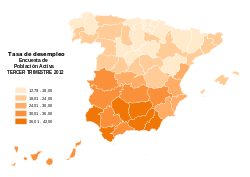Unemployment in Spain

Though unemployment is a general problem for the whole world, the degree of unemployment in Spain is especially high in respect to the other countries in the region at the same economic level.
After reaching a minimum of 8% between 2006 and 2007, with the Spanish economic crisis that began in 2008 the rate of unemployment grew quickly exceeding 20% in 2010 and 25% in 2012[1][2] and unemployment became the greatest concern[3] within Spanish society. Even though unemployment in some regions of Spain is slightly less than in others, the general amount is one of the highest in the European Union and in general has stayed like that independently of the economic situation. Almost 100,000 people have lost their jobs in the real estate industry in Spain.[4]
Causes
Spain suffers a high level of structural unemployment. From the economic and financial crisis of the 1980s, unemployment has never dipped below 8%. Spain is the OECD country with the highest unemployment rate, ahead of Ireland and Greece. The main causes are an economy based mostly on tourism and building sectors, and lack of industry. The most industrialised region is Basque Country (where industry is around 20–25% of its GDP); its unemployment rate is 2.5 times lower than those of Andalusia and Canary Islands (where industry is only 5–10% of their respective GDP). In the last thirty years the Spanish unemployment rate has hovered around double the average of developed countries, both in times of growth as in crisis. From the start of the crisis of the 1990s, unemployment fell from 3.6 million to two million, but that figure stagnated throughout the good times to the present crisis.
Consequences
Socio-economic consequences
Unemployment reduces household income and therefore domestic consumption and quality of life. The mental health of the unemployed and their families deteriorates. The emancipation period is extended and therefore the birth rate decreases as it is difficult to start a family with minimal economic guarantees. Social exclusion is triggered, evictions increase, and families start to default on bills for basic utilities such as water, electricity and gas, leading to energy poverty.
International impact
The dramatic situation of unemployment in Spain, and its consequences not only continuously open the editions of Spanish media, but have also cornered the main pages of the most important international media.
Unemployment rate
It is obtained through a procedure known as Economically Active Population Survey. In fact, it is a survey made every three months to some homes about their recent work history. The survey divides the population of 16 years or more in four groups:
- Occupied people: Those who have carried out paid work, as well as those that have jobs but are absent because of illness, strikes or holiday.
- Unemployed: are the people that are not occupied, but that they have sought work actively or are waiting to return to work. More exactly, 1) a person is unemployed if he/she is not working and has made specific efforts to find employ during the last four weeks; 2) has been suspended from employment and is waiting to be called new or 3) is waiting to occupy a job the following month.
- Inactive: This category includes the percentage of adult population that is studying, does household chores, is retired, is too sick to work or if is simply not looking for work.
- Active Population: includes persons who are both employed and the unemployed.
The unemployment rate is calculated as the number of unemployed workers divided into the active population, and it is expressed as a percentage. In other words, it is not a proportion between the total of the unemployed people and the total population, but economically active people.
See also
References
This article was adapted from the equivalent Spanish-language Wikipedia article on April 20, 2013.
- ↑ Estadísticas según periodo en el INE
- ↑ Tasa de desempleo en España según la metodología de Eurostat
- ↑ diario de avisos.com. "El CIS revela que los españoles siguen teniendo los mismos problemas: el paro, la economía y la clase política".
- ↑ http://topspanishhomes.com/news/more-100000-people-lost-their-jobs-spanish-property-market